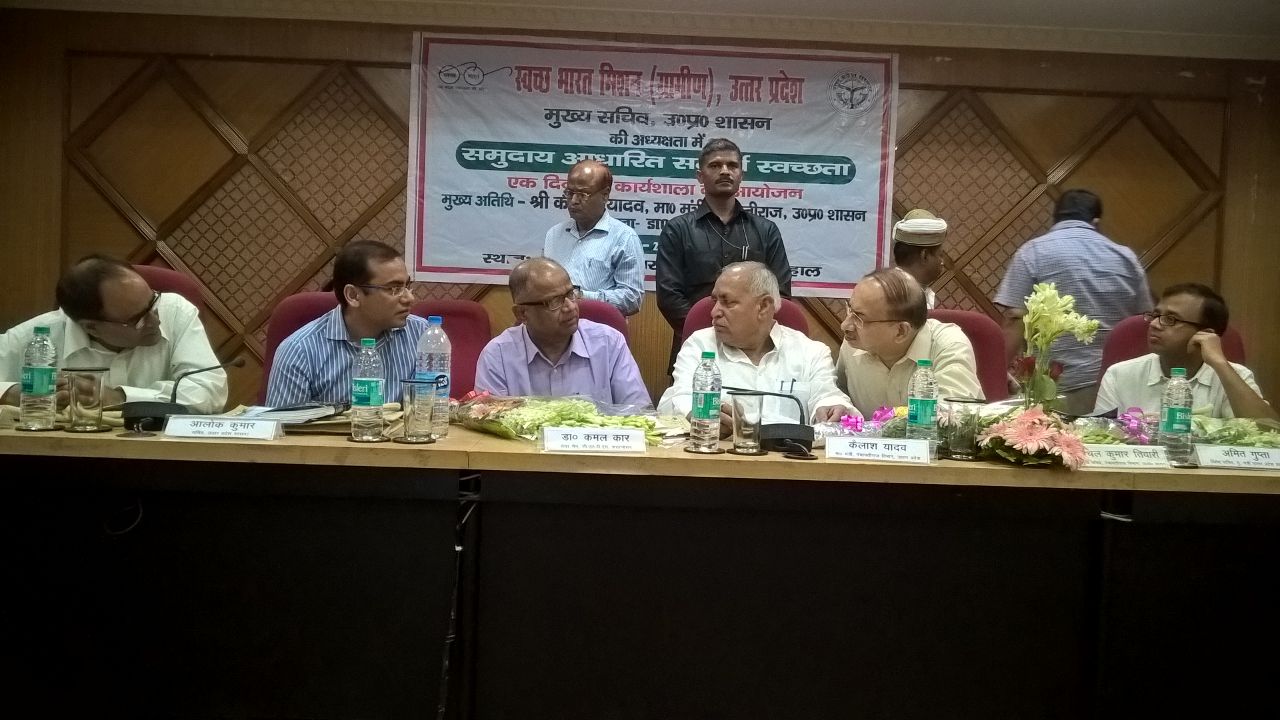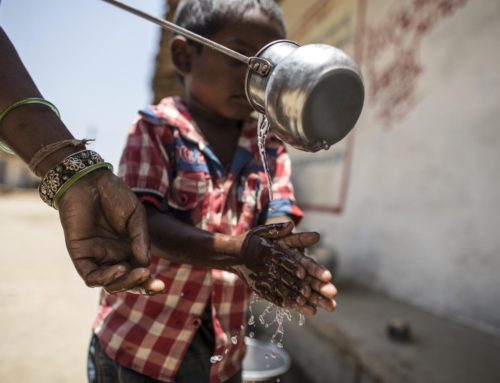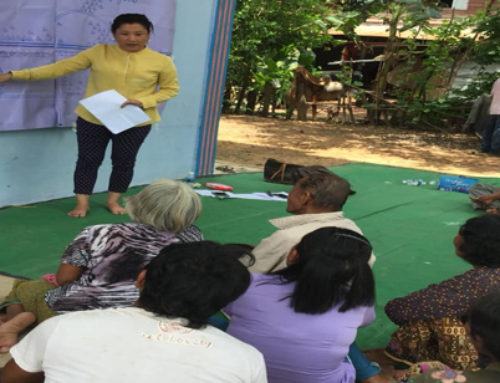By Dr. Kamal Kar

India is home to 58% of the world’s open defecators and Uttar Pradesh (U.P.), India’s largest and most populous state contributes significantly to India’s poor sanitation status. The population density of open defecators in the state of U.P. is one of the highest in the world (12% of open defecators of the world live in the state* ) and the Census 2011 data points out that 78% population in U.P. do not have access to basic sanitation.
Interestingly, the U.P. government has started a unique initiative to usher in the Community–led Total Sanitation (CLTS) approach in the country with a renewed vigour after it was successfully adopted and introduced by the state government of Himachal Pradesh eight years ago. Himachal Pradesh saw a 60-70% increase in sanitation coverage over a period of 4-5 years during 2006-2010, when CLTS was implemented with the right enabling environment required to make it successful. Inspite of the state’s demonstrated success, so far there has been no enabling environment ensured for CLTS to succeed in any other state, barring a few successful attempts made in states such as Haryana and Maharashtra. This was possible due to the great commitment shown by a few individuals who emerged as institutional champions within the bureaucracy and the political leadership.
CLTS was introduced in India almost immediately after it was innovated in Bangladesh. As the story of success of CLTS in Bangladesh started spreading, this attracted the attention of the neighbouring countries and a major orientation workshop was conducted in Bangladesh Academy of Rural Development (BARD) in Bogra in 2002. More than 20 senior officials from different states and the Central government of India participated in the two-day workshop to explore the possibilities of bringing the approach in India for enhancing the access to basic sanitation in rural areas. Amongst others it was Shri B.C. Khatua, the then Principal Secretary, Water Supply and Sanitation Department, Government of Maharashtra, who was convinced about the ability of CLTS in empowering and mobilising local communities to initiate collective action towards ending open defecation without waiting for any outside subsidy or dole. With this conviction, Shri Khatua was determined to pilot this approach in two districts in Maharashtra and ensured that no upfront household hardware sanitation subsidy was given to the two pilot districts. These two districts were Ahmednagar and Nanded. The CLTS pilots in the two districts were successful and they created a lot of interest in the state government of Maharashtra. Subsequently, the approach was introduced in all the 32 districts in the state through a series of hands-on training workshops, advocacy and post-triggering follow up activities. A number of government officials, elected people’s representatives, like the Chairman/Deputy Chairman of Zilla Parishad, ministers and NGO’s were taken to Bangladesh for exposure visits over a period of a next couple of years.
With face to face interaction and consultation with the local administration, the visitors from India were more than convinced of the efficacy of the CLTS approach in enhancing the access of rural sanitation by allowing the community to take the lead. The story of rural sanitation in Maharashtra started changing rapidly. High level delegations including ministers and secretaries from the states of Haryana, Himachal Pradesh, Andhra Pradesh, Karnataka and Rajasthan visited the open defecation free (ODF) villages in the two pilot districts and other districts of the state of Maharashtra in later years.
Being motivated by the power of CLTS in changing the mindsets of the community in stopping open defecation, some of the state governments introduced the approach on a pilot basis and experienced instant successes sporadically. However, the individual household hardware subsidy under the Nirmal Bharat Abhiyan (NBA) continued to be the prevalent policy, thereby preventing the scaling up of small successes across the block or the district. Naturally, the dream of an ODF state was a far cry. Meanwhile, a remarkable decision taken by the government of Himachal Pradesh in 2005 of abolishing upfront, individual, household hardware subsidy and getting the approval of the assembly through legislation was ground breaking. Within the three and a half years of adoption of CLTS in the state sanitation policy, access to basic sanitation of the state moved to 84% from a meagre 34%. It is important to mention here that the success was only measured in terms of counting ODF communities and not the number of toilets.
However in 2012, the subsidised approach to rural sanitation was brought back by the state government stalling the progress being made in the state. One important factor why most of the state governments were hesitant in adopting the no-upfront hardware household sanitation subsidy was because they didn’t want to lose the lion’s share of the hardware cost for toilet construction being provided by the central government. Although the central government allowed the states flexibility in choosing their implementation strategy, the mechanisms for monitoring the state’s progress still remained restricted to the number of toilets constructed and the money spent for these purposes. Thus the central issue of measuring the health impact resulting from sanitation interventions was not given any attention at all. Further, the fact that this impact could only come about as a result of collective hygiene behaviour change focused on producing ODF communities instead of just toilets, remained invisible. This has been India’s sanitation story for decades now, and this trend of increasing subsidy provision as the panacea to India’s sanitation crisis has continued well into the Nirmal Bharat Abhiyan (NBA) era and exists now in its newly incarnated avatar, the Swachh Bharat Mission (SBM).
In spite of this, over the years, sporadic cases of successful CLTS stories have emerged due to the personal initiatives of individual champions in districts [district magistrates (DMs), elected people’s representatives, senior government officials of states, etc.], a few sterling examples being Panipat and Hisar in Haryana; Jalna, Nanded and Ahmednagar in Maharashtra; Guna in Madhya Pradesh, Angul in Odisha and Bikaner in Rajasthan. These cases clearly show that achieving ODF environments through community empowerment is possible in India, as in other countries of the world. In fact, since CLTS was introduced in the year 2000, India has been one of the countries where a large number of CLTS training workshops have been conducted, but its outcome in terms of the number of ODF villages produced have been very minimal. This has happened because CLTS triggering has been viewed narrowly as the application of CLTS tools, with no proper post-triggering follow-up to ensure that communities become ODF. Also the absence of an enabling environment to transform collective behaviour change has made it very difficult for CLTS successes to be scaled up across districts and the entire state. This is an issue not particular to India alone. A huge gap in the ratio between triggered vs ODF communities exists in many other countries as well. However, many of them have begun taking corrective measures by learning from their past mistakes and allowing the community to take the lead towards making their environments ODF
This current initiative by the government of U.P. to implement CLTS as a pilot project in a few districts could really be a pioneering initiative in India. I am finding hope in the fact that at least the state has started thinking in the right direction, of creating the right enabling environment for scaling up community-led initiatives. If this yields an encouraging result, certainly this will pave the way for a new thinking in sanitation sector interventions in India for rapid change.

The one-day workshop held in Lucknow on June 27, 2015 brought together more than 150 government officials from all over the state. The Panchayati Raj Department invited the 10 top performing DMs from the state, about 15 District Project Co-ordinators, and District Panchayati Raj officers from the 75 districts of the state. Hearing of the experience of CLTS in different countries across the world and realising the potential of the approach to change the sanitation situation in U.P., Hon. Shri Kailash Nath Yadav, Minister of Panchayati Raj; Hon. Shri Chanchal Kumar Tewary (IAS), Principal Secretary, Panchayati Raj; Shri Alok Kumar (IAS), Chief Staff Officer to the Chief Secretary, and Shri Amit Gupta (IAS), Special Secretary to Chief Minister, Uttar Pradesh decided to initiate full-fledged activities to introduce CLTS in select 10 districts and urged all officers from 75 other districts to kick start CLTS in their respective areas.

Discussions with Hon. Shri Kailash Nath Yadav, Minister of Panchayati Raj and other senior government officials on the sidelines of the workshop
A meeting with Shri Alok Ranjan (IAS), Chief Secretary of State later helped in moving forward the day’s discussions towards a concrete action plan, as the Chief Secretary was convinced that this was the way to move the state forward.

Shri Alok Ranjan, IAS,Chief Secretary of State, Govt of U.P. and Dr Kamal Kar, Chairman, CLTS Foundation in an informal meeting
When I reflect on what has made this development in U.P. possible, I believe this has been due to the relentless work and persuasion of Alok Kumar, who many years earlier, participated in one of my lectures on CLTS at the Administrative Training Institute in Nainital in 2010. His motivation and enthusiasm for CLTS, that led to him introduce the approach in Saharanpur district, where he was the DM at that time. It was one of the districts to produce some of the earlier ODF villages in India. The success of CLTS in Saharanpur district strengthened his conviction that CLTS is the approach that will work on a large scale if facilitated properly along with post-triggering follow up ensured within the right enabling environment. Like Alok Kumar, a number of DMs have been equally successful in rolling out CLTS in a small scale in different districts of the country. In the Indian context, DMs/Collectors/Deputy Commissioners enjoy an enormous authority and respect from all the line departments working in a district. When a district officer like a DM is convinced and drives CLTS, it is as good as enforcing a law and ensures a very high level of enabling environment although it is not written on any official document.

The informal meeting at the Chief Secretary’s residence
Now, we will wait and see whether U.P. emerges as an example for the other states in producing concrete results on the ground by adopting an appropriate sanitation policy that empowers local communities for the 10 selected districts. Considering that the upfront hardware and subsidy approach has failed to bring about the desired results and health outcomes in the state so far, it is to the credit of the state authorities that they are now taking ownership for community-led initiatives and paving the way for CLTS to be implemented and scaled up in the state.







Leave A Comment